A beginner gardener's guide to growing and caring for family onions
Family onion is the popular name for a multi-bud onion, in the nest of which from four to eight bulbs are formed. The culture is distinguished by strong immunity, long shelf life and early ripening. When planted in April, the crop is harvested in early July.
In the article we will tell you about the features of family onions, their cultivation and care.
The content of the article
Description and characteristics of the family bow
Family bow (lat. Allium ascalonicum) has been grown since ancient times. This type of onion is considered the tastiest and most fruitful.... The plant has other names - kuschevka, shrike, kvochka.
The most popular variety is shallots, with small oblong bulbs of white or white-purple color, delicate taste and aroma.
The main characteristics of the culture:
- The family onion differs from the usual onion structure - a nest with 3-12 small heads is formed from one bulb. In some cases, their number reaches 20.
- Average weight - 15-60 g.
- The shape is varied: oblong, cuboid, pitcher-like, round, ovoid, elongated.
- The color of the scales is golden, red, purple, bronze.
- The middle on the cut is white, pinkish-purple, reddish shades.
- The greens are dense, the leaves are softer and thinner than those of a turnip, with a slight waxy bloom. Feathers can be cut or plucked from the bulb 2-3 weeks after planting. They do not coarse, remain gentle throughout the season.
- The height of the ground part is 30-50 cm.
- Taste - semi-sharp, does not leave a sharp aftertaste and bad breath.
- The heads ripen in 50-80 days, depending on the variety.
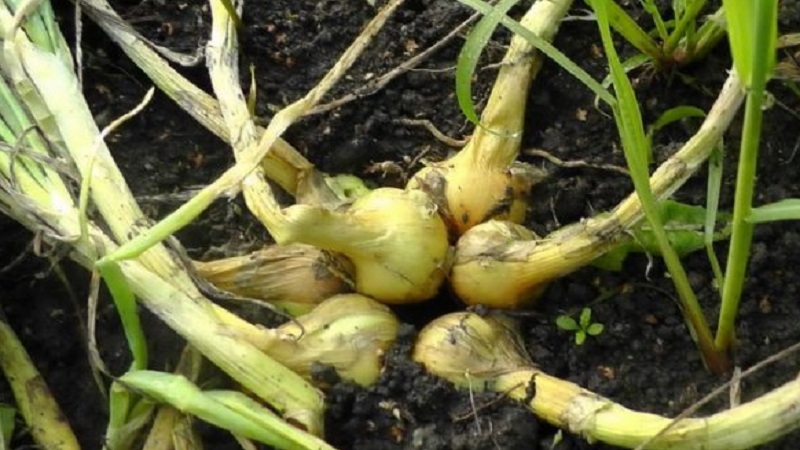
In the photo you can see what a family bow looks like.
Features of growing in the open field
Family bow is frost-resistant, not subject to shooting, therefore, planting is carried out starting from the second decade of April, subject to favorable weather conditions.
Long daylight hours, active snow melting is the best period for plant growth and development... The bulbs are literally saturated with melt water. Suitable air temperature + 18 ... + 20 ° С. Seeds germinate quickly in soil warmed up to + 4 ° C.
For a large harvest choose bulbs larger than 3 cm.
To prevent spreading on the site onion fly rows of onions alternate with rows of carrots.
When growing family onions fresh manure is not recommendedotherwise you will end up with thick and tall greens instead of large bulbs.
To get large heads, it is important not to thicken the planting. and control their number in the garden. For this, the earth is raked off and extra copies are twisted. They can be used for food. The remaining bulbs get enough room to grow and develop.
In the greenhouse
Planting material less than 2 cm in size is used for forcing early greens in the heifer... Planting is carried out in January, taking into account the long dormant period characteristic of the plant.
The best varieties of family onions
When choosing a variety of family onions, experienced gardeners recommend focusing on varieties adapted for growing in a particular region.
The table shows the main characteristics of the best varieties.
| Variety name | The form | Bulb weight, g | Coloration | Keeping quality | Productivity, kg / 1 m² |
| Albik | Transverse elliptical | 10-20 | The husk is yellow, the scales are white-green | Seven months | 1,5 |
| Velikoustyugsky | Rounded | 18-22 | Husk - brown-red, scales - white-purple | Seven months | 0,8 |
| Guarantee | Transverse elliptical | 15-25 | The husk is yellow, the scales are white-green | 6 months | 1,7 |
| Knyazhich | Elliptical | 20-25 | Husks - red-brown, scales - purple | Seven months | 1,2 |
| Sturdy | Rounded | 25-30 | The husk is pink, the scales are red | 6 months | 2,1 |
| Krasnoselsky | Transverse narrow-elliptical | 40-50 | Husks and scales of red color | 8 months | 3 |
| Earring | Rounded | 20-25 | Husk - yellow, scales - white | 8 months | 1,5 |
| Sophocles | Rounded | 25-30 | Husks - brown-purple, scales - white-purple | Seven months | 2,2 |
| Old Believer | Elliptical | 15-18 | Husk - brown-red, scales - white-purple | 6 months | 1,2 |
Correct fit
Family onions are grown by seeds - in order to renew the planting material, and by heads - to obtain large bulbs and greens... Spring planting is performed throughout Russia in April-May. In the south, it is possible to plant onions before winter.
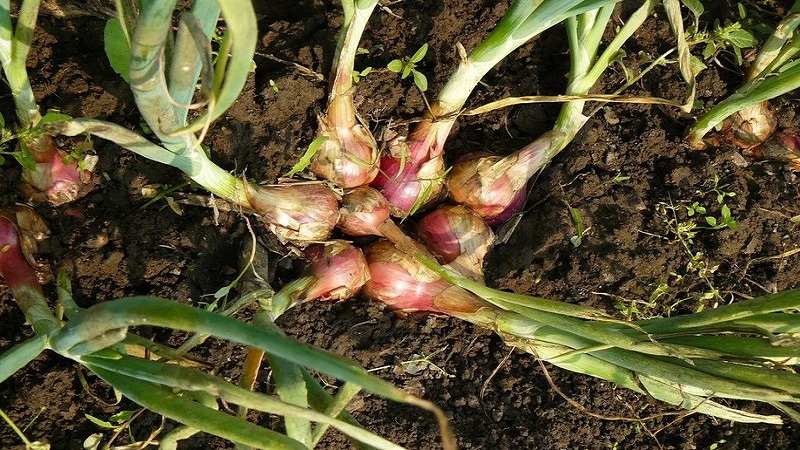
Landing dates in the regions
Timely sowing is the key to successful plant growth and development, the formation of a nest with a large number of bulbs... Given the cold hardiness of family onions, in most regions of Russia, planting begins in the second decade of April. Greens calmly tolerate frosts down to –7 ° С.
In the south, spring planting is performed at the beginning of April, and winter planting at the end of October.
In the Urals and Siberia, the dates are slightly shifted. Family onions are planted taking into account weather conditions - in late April-early May. Planting in winter is rarely carried out due to the risk of losing more than half of the crop. If warm weather lasts longer, family onions are planted before winter in November, covering the beds with a thick layer of mulch (about 10 cm).
Lunar calendar
To obtain large bulbs, planting is carried out on the waning moon, for forcing greens - on the growing.
Auspicious days for forcing greens according to the lunar calendar for 2020:
- April: 2-7, 24-29;
- May: 1-6, 23-29.
Auspicious days for getting heads on the lunar calendar for 2020:
- April: 9-14, 16-22;
- May: 8-13, 15-21.
There is an opinion that it is better to complete the planting of a family onion before May 5. In the people - this is Luke's day, or Luke's day.
Preparation of planting material
Medium-sized seeds are best for planting.... They form an average number of large bulbs. Large seeds produce a large number of small specimens.
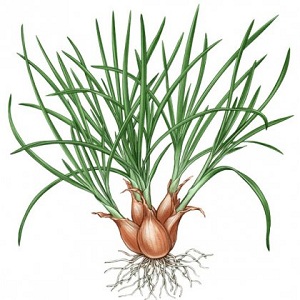 The bulbs are peeled from the scales to reduce the risk of infection fungi and disinfected in a solution of potassium permanganate, salt (50 g per 2 liters of water), the drug "Maxim".
The bulbs are peeled from the scales to reduce the risk of infection fungi and disinfected in a solution of potassium permanganate, salt (50 g per 2 liters of water), the drug "Maxim".
Then washed with clean water and soak in nutrient solutions (optional):
- 50 mg boric acid per 1 liter of water;
- 1-2 g of succinic acid per 1 liter of water;
- 1 g of potassium bromide per 1 liter of water.
Dry the material before planting. on open air.
Seeds from a bag are pre-soaked in water for 48 hours, periodically changing it. Then the material is dried until flowable and sown into furrows with an interval of 8-10 cm. The width between the grooves is 15 cm. 2-4 small bulbs are formed from one seed. So it is possible to grow a family onion set, which can be used for planting next season.
If there is not enough material to fill the prepared area, the landing is performed in halves or quarters. In large bulbs with a diameter of 3 cm and a weight of 30-50 g, dry scales are cut off and the bottom to the roots. The bottom is covered by a hard part, popularly called the "heel", which must be carefully cut off. This stimulates the appearance of roots.
The prepared material is soaked overnight in water at room temperature., before planting, divide into two or four parts with a sharp knife along the onion.
Note! The roots of family onions are unevenly located on the bottom, so when cutting, make sure that approximately the same number of roots remain on each part.
Site preparation
For growing family onions, plots are allocated on the southern side of the gardenwell warmed up by the sun, no drafts. The soil should be loose and nutritious. Sour and clogged soil is not suitable for onions.
The best predecessors of culture - pumpkin, squash, zucchini, legumes, potatoes, rye, flax, lupine. The plant is re-planted in the same place no earlier than 3 years later.
If necessary, increase soil fertility by plowing and the introduction of up to 5 kg of humus per 1 m², 200 g of wood ash, 40-50 g of superphosphate.
The heavy clay soil is loosened using river sand - 5 g per 1 m².
Soil temperature when landing must be at least + 5 ° С.
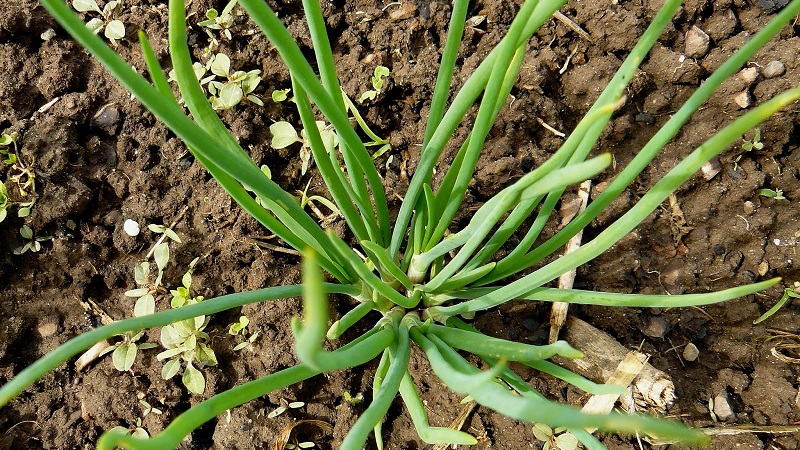
Planting instructions
A bed is formed on the site and 2-3 deep furrows are made... The planting material is laid out in a checkerboard pattern. A distance of 25-30 cm is left between large bulbs, of medium size - 15-20 cm.If the task is to distill greens, the interval between seeds is 10-15 cm.
Planting depth - 5-8 cm, sprinkle the top with soil with a layer of 3 cm for better rooting. When planted shallowly, the root system dries quickly and does not develop.
Small bulbs with a diameter of 1-2 cm are left for winter planting in October... Before the onset of frost, the planting material will take root and overwinter without negative consequences. In early spring, you can cut off young greens or leave onions on the head.
Further care
Rules for caring for family onions:
- Abundant watering at the beginning of the growing season. Lack of moisture leads to the end of the growing season, the bulbs will not be able to grow to the desired size. Watering rate - 200 liters per garden bed. Watering is stopped three weeks before harvesting.
- To retain moisture in the soil the beds are mulched with sawdust, straw, dry leaves or peat. This coating inhibits the growth of weeds and reduces weeding.
- In the beds intended to obtain large heads, greens are not cut... If you want to use a green feather for cooking, the earth is shaken off, the head is carefully unscrewed from the middle of the nest.
- At the beginning of July, the nests are broken - part of the soil, together with the mulch, is raked off, leaving the heads ½ in the open air for drying and quick ripening.
- If the previous crops did not feed, additionally add 10 g of urea, 40-50 g of superphosphate and wood ash.
Disease and pest control
Family onions are less likely to suffer from fungal diseases than other types of turnip and is attacked by an onion fly.
Sometimes wilting and yellowing of greenery is observed... The culprit of such changes is aphids. To destroy the pest, infusions based on hot pepper are used (2-3 pods, chop and pour 1 liter of water), yarrow (300 g of dry raw materials, pour 5 liters of water) or bitter wormwood (0.5 g of grass, pour 10 liters of water). 25-30 g of liquid or 50 g of shavings of laundry soap are mixed into the liquid for better adhesion of solutions to the leaves. The biological product "Verticillin" is highly effective.
To scare off onion flies, fresh branches of wormwood are laid out in the beds, tansy and yarrow. Once every 7 days, the ground part is watered with saline (200 g of salt per 10 liters of water).
If the rules of agricultural technology are violated, the family bow affects powdery mildew, downy mildew, neck rot. Infected plants are removed from the beds, healthy ones are treated with "Quadris", "Mikosan", "Pentofag".
Preventive measures:
- disinfection of planting material with drugs "Maxim", "Fitosporin";
- crop rotation;
- weeding.
Onion nematode bends the bottom of the bulbs... Infected planting material infects healthy plants. For prophylaxis, before planting, the bulbs are treated with a 4% formalin solution.
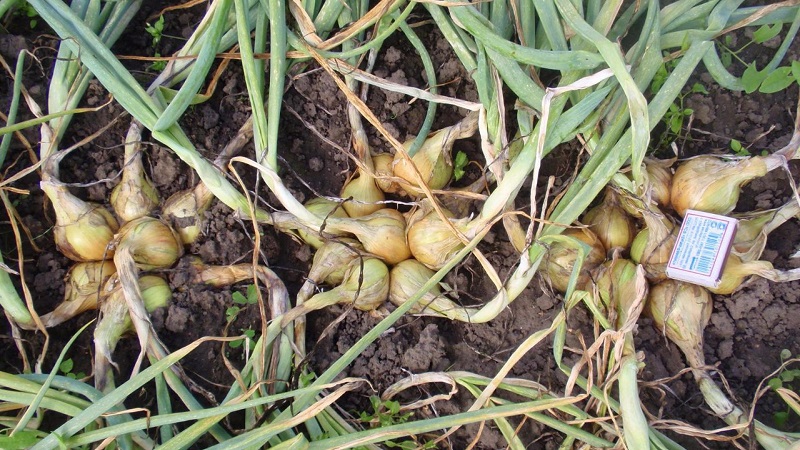
Harvesting and storage
Family onions usually ripen in the second half of July and early August.... Signs of the readiness of the crop for harvesting: wilting and lodging of greens, dry scales on bulbs, dry necks.
Onion it is undesirable to overexpose in the soil due to the risk of decay of the socket into heads.In a humid environment, they re-root, which leads to a shorter shelf life in winter.
Harvesting spend in dry sunny weather: the earth is shaken off, the roots are cut off, the bulbs are laid out on nets for drying, ripening and disinfection in the sun.
In rainy weather, the heads are dried under a canopy, in an attic or in a shed for 10-12 days. The dry feather is cut off, leaving 10 cm. This is the most convenient way to weave "onion braids".
Conveniently hang the family bow in a house at a temperature not higher than + 20 ° C.
In the cellar, onions are stored underground, in wicker baskets or spacious boxes. This storage method provides for the complete removal of dry feathers. The optimum air temperature is 0 ... + 2 ° С.
It is not recommended to store family onions next to potatoes, beets, carrots and other vegetables that require high humidity.
Conclusion
Taking care of the family bow is not difficult. It is important to ensure sufficient watering at the beginning of plant development, mulch the soil to facilitate cultivation of the beds, and periodically thin out to provide space for large heads to form.
An important condition for the successful cultivation of family onions is the choice of medium-sized planting material and pre-planting soaking in water, nutrient solutions, disinfection with Maxim or Fitosporin preparations. Follow the basic rules of care, and the onion will delight you with an abundance of harvest!